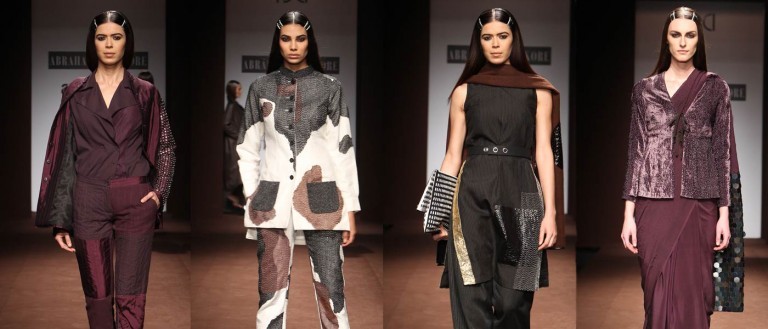Abraham and Thakore:
Globally Successful Fashion Designers Who Write Their Own Rules
Abraham and Thakore is a unique Fashion Design success story, built on a core of innovation, quality and commitment to personal values – including Sustainability.
David Abraham and Rakesh Thakore are unconventional rule-breakers who have followed their own path to success – not through outrageous designs, but by letting their principles shine through in their work and they way they run their business.
Their exquisite, wearable clothes appeal to a wide audience, from middle class women with normal bodies to some of the most popular stars on the planet.
We take a look at the men behind the clothes, and explore why you find their work at art galleries as well as catwalks around the world.

© Abraham & Thakore
Abraham and Thakore in a Nutshell
David Abraham and Rakesh Thakore met as students at India’s National Institute of Design. They carved out individual careers before joining forces in the 90s to set up their eponymous label.
Listing some of the typical words others have used to describe the "super elegant and chic designer duo" and their designs paints a telling picture:
successful and respected
designs that eclipse their competitors
never trend-followers
the eternal experimenters
a refreshing take on tradition
sticking to their philosophy
shockingly wearable clothes
low key yet highly distinctive
For a glimpse beyond that, we should look to language they’ve used to describe themselves and their approach to fashion:
Artists first and foremost
We’re not business people, we’re happy doing what we’re doing
[We have] a loyal and discerning clientele who understands and appreciates our ethos, which is very rewarding
While we love creating beautiful product we have always been troubled by . . . the wastefulness of constantly changing trends
One single consumer can make a tiny but positive difference in favour of the environment
Of course their clothes say as much as any words, as we see in the pictures throughout this article.
Citizens of the World, Based in India
It would be easy to look at David and Rakesh and see two Indian men in the Fashion industry, with the many associations, assumptions and stereotypes each of us carry with that tag, often unconsciously.
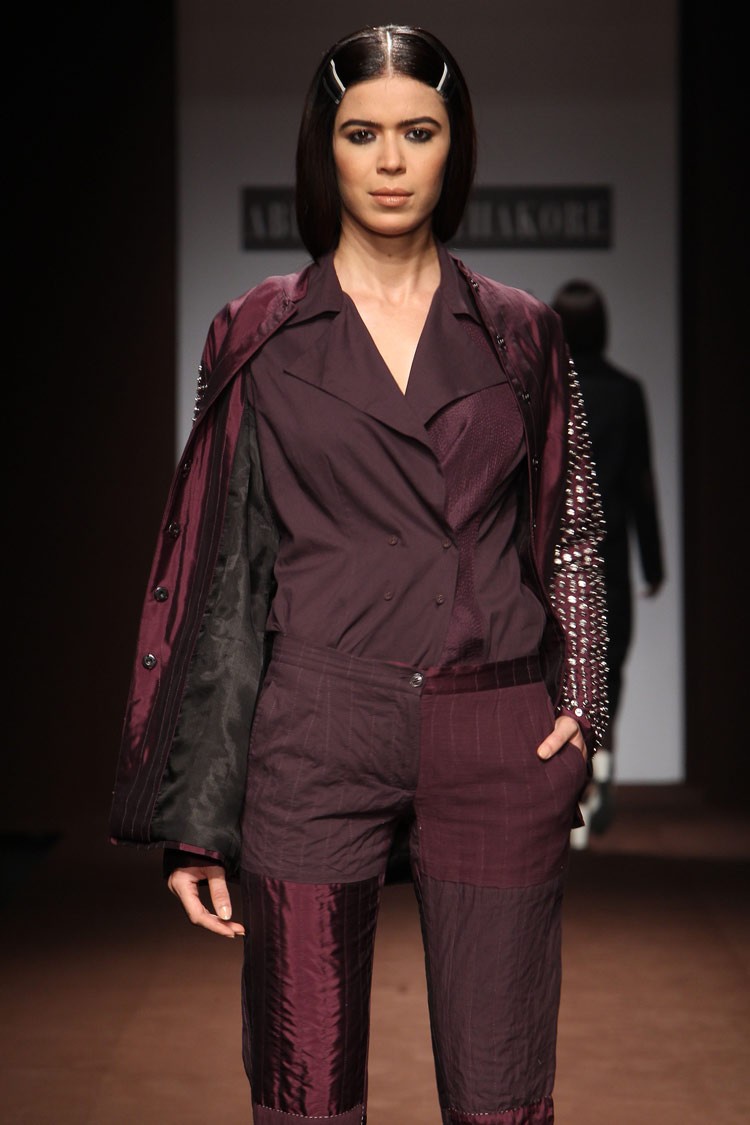
© Abraham & Thakore
But the reality is rather different, and goes back to their earliest roots. One part of appreciating their achievements today is to understand their diverse, international backgrounds.
Global Beginnings
David Abraham was born in Singapore, where his doctor father lived. Through his Chinese mother, he has plenty of Chinese relatives whom he still visits in Singapore and Malaysia.
Rakesh Thakore was brought up nearly 5,000 miles further East along the Equator, in Tanzania. But his surroundings could hardly be more different, on his family’s 4,000 acre farm (said by some to be near the final resting place of Noah’s Ark).
They both studied in India – David went to school in cosmopolitan Bangalore and Rakesh in India’s commercial capital of Mumbai. Their paths first crossed at the National Institute for Design (NID) in Ahmedabad, where they spent five years learning their craft, and also building some lifelong friendships – including their own.
After NID they went in different directions, but each still seeing the world through a more cosmopolitan, international lens than many of their contemporaries.
International Appeal from the Outset
David Abraham started his career with an American buying house, where his designs were a hit with the American mass market. By 1993 designs in his own name were to be found in Park Avenue windows, priced appropriately for the setting.
But despite the commercial success, the desire to decide their own direction was irresistible. So he and Rakesh set up their own label, converting David’s front room at into their office.
They soon found themselves being asked to supply London’s iconic Conran Shop. An early sign of their intent came when Conran tried stipulating that the designs would be labelled theirs rather than Abraham & Thakore, but the designers refused outright.
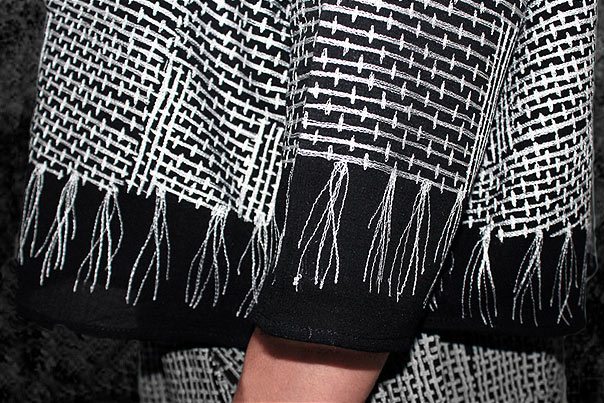
© Abraham & Thakore
And so a now-familiar pattern started: Abraham & Thakore branded items stocked by the most prestigious stores in the most style-conscious cities around the world.
The early days were not as glamorous as they might sound now, and the pair put in the hard work that any successful business demands. This included travelling to London with suitcases of clothes, knocking on doors of buyers and letting the designs speak for themselves.
They were joined by Kevin Nigli, who completed the 3 man team that has guided the brand to the upper echelons of the industry.
It was not until 2002 that the first Abraham & Thakore store opened in India. But within 3 years they had stores in several big cities, and their clothes were available across the country.
This was all happening at the same time that they were expanding outside India, reaching out from London to Paris, New York, Rome, Singapore, Tokyo, Kuwait and beyond.
While their international outlook explains in part how they’ve gone about things, a bigger influence comes from their maverick personalities. From the outset, they showed a determination to do things they way they felt things should be done, regardless of conventional wisdom.
A Healthy Disrespect for Convention
(In the Fashion Industry and Beyond)
An Education Designed to Open Minds
One of the characteristics that comes through in virtually every description of the designers is the way they have shunned convention.
While this is very likely part of their personal make-up, the environment at NID would have been a welcome catalyst, and it’s little wonder that they speak with such warmth of their time there.
There were only six in their Textile Design class, which was evaluated solely on project work. The absence of exams is arguably one of the most un-Indian things you’re likely to find in their stories!
One project required them to wander the city with cameras and take photographs. Another involved watching world cinema non-stop. And each student had their own loom, and had to weave every day.
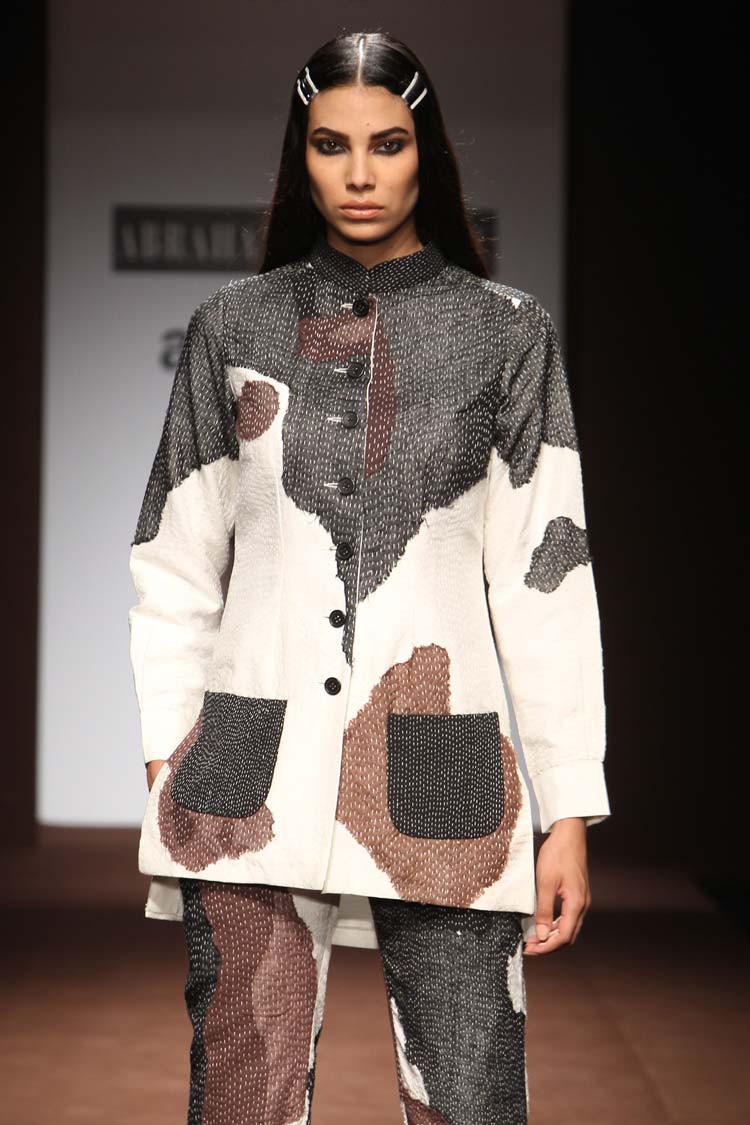
© Abraham & Thakore
In other words, their initial education reinforced any pre-existing tendency to ignore rules and convention, and follow their own path.
Who Needs the Catwalk?
Fast-forward to 2010, and you find one another telling example of the Abraham and Thakore attitude to industry norms.
On a March evening in Delhi they were preparing to introduce their Winter Collection at India Fashion Week. What made it notable was that after 18 years, it was their first ever show . . .
Today people are as likely to discover their work at leading design museums as the catwalks of London, Milan or Paris. And in Paris, their presence of choice next year is the art-oriented Salon, Maison&Objet rather than a more traditional slot in the Paris Fashion Week schedule.
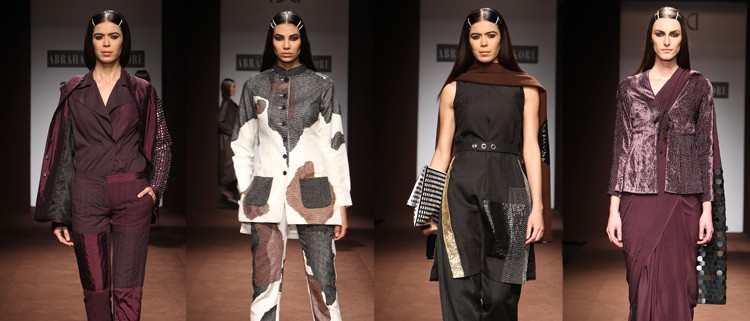
© Abraham & Thakore
Their individualistic outlook doesn’t just apply to how they operate in the industry, but their interpretation of the lifestyle that goes with it. Behaviours like preferring coffee to wine, and being on time for meetings, have been commented on by observers more used to designers who party hard and show little courtesy towards others.
Timeless Design Doesn’t Need to Rely on Fashion Season Cycles
Another example of ignoring fashion industry norms comes from their take on the word “timeless”, which results in them carefully selecting when and why to appear in fashion shows, and doing so sparingly.
To them, continually changing styles for each season is not of itself a real need. Presenting at every show for its own sake is not sacrosanct for them, and is rather a cause of wastefulness for no good reason.
Of course they are acutely aware of the need to stay connected with the evolving desires of their customers, and also acknowledge the critical role of marketing and branding in today’s industry.
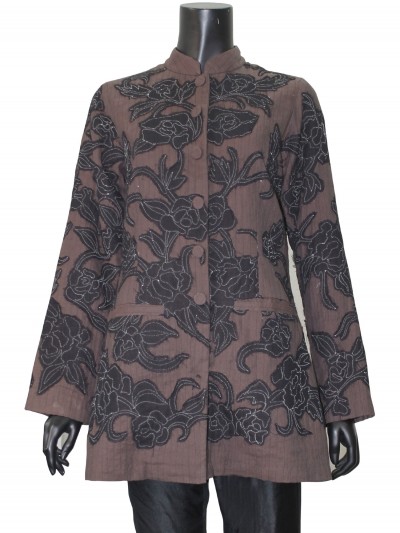
© Abraham & Thakore
But they play the catwalk game on their terms, as part of their creative response to a constantly changing world. In David's own words:
Markets are [constantly] changing, and participating and showcasing a strong collection will only make the buyers and retailers aware of our work and product. But that doesn’t mean we will do every show, we’ll only do a show when we have a collection that needs to be showcased.
Abraham & Thakore’s Signature:
Not a Look, A Philosophy
To us, we don’t see a single Abraham and Thakore visual style, but instead an overarching approach, mindset and philosophy. So while individual collections each have their own identity, there is a family character to all of them that goes beyond any one set of pieces.
Their Fashion Design Council of India webpage alludes to many of these elements:
quiet and modern . . . low key yet highly distinctive, with a strong respect for material, form and craft . . . the very modern synergy between fashion and lifestyle . . . for the way the contemporary urban consumer dresses and lives whether in New Delhi, London or Tokyo.
We’ve discerned four elements across their work that together make up our view of Abraham and Thakore designs.
Wearable & Appealing to “Normal” Women
As you’d expect, they have many fans on the Bollywood “A List” and in the most exclusive districts of the world. But their clothes are actually priced and designed for middle class professional women.
It’s important to them that the pieces are accessible to the kind of women who make up everyday life, including work. Regular women with normal shapes can look good in their designs, not just models.
And it’s not just the cuts and shapes, but also the look. People don’t choose Abraham and Thakore to make wild and dramatic statements aimed at capturing camera time. Rather they have learned to expect clothes that are intended to be worn while living real lives, providing elegance and class, with an air of understated intelligence.
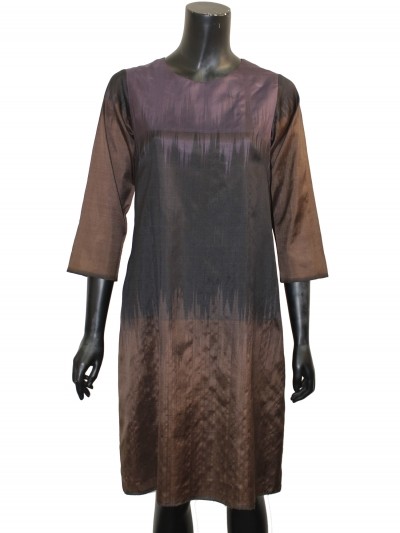
© Abraham & Thakore
As David told the Hindustan Times a few years ago,
That’s why many professional women find that our clothes work for them. We are more interested in style, less interested in fads
We think this acknowledgment of real people and their circumstances is one of Abraham and Thakore’s defining characteristics.
Respect for Fabric
From the earliest days both designers have had a fascination with fabrics. Rakesh in particular is passionate about developing sophisticated hand woven materials.
He has elevated their mastery of fabric to the point where the world’s leading institutions showcase Abraham and Thakore materials in major textile exhibitions, names such New York’s Metropolitan Museum of Art, the V&A and the Musee des Arts Decoratifs in Paris.
The fabrics are designed and incorporated into their collections with a sophisticated eye, and a deep appreciation of texture and form as well as colour and shape.
Looking Afresh at India’s Textile & Creative Heritage

© Abraham & Thakore
Something that is mentioned in virtually everything written about Abraham and Thakore is the way they draw on India’s rich tradition of design and craft.
Anyone who knows of India’s craft heritage will know of the beauty, intricacy and skill that manifest so diversely across the sub-continent.
But for many years, the Western view of Indian fashion was a crass caricature, with only lowest common denominator styles reaching foreign eyes. As long ago as 1993, David was bemoaning this to the Washington Post, describing what the West knew of Indian clothes as "some of the ghastliest in the world".
Since then, Abraham and Thakore have been at the forefront of showing the world how much Indian tradition can contribute to 21st Century global fashion, especially when applied creatively.
But it needs to be properly understood, for example as David explains when talking about incorporating Indian fabric traditions,
It’s about respecting the material. For instance, handloom can’t be made into drainpipe jeans. You have to understand the fabric.
“Western” or “Indian” Style? They Reject the Question
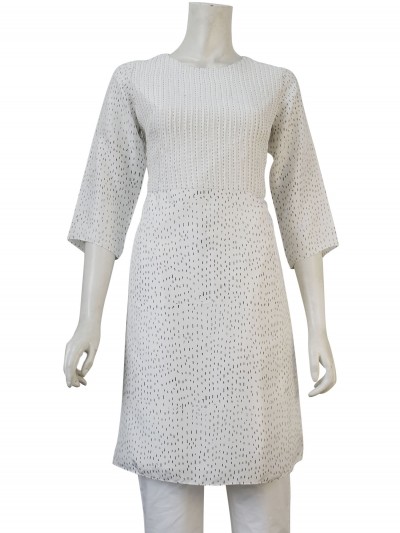
© Abraham & Thakore
The globalization and heady growth of the Indian economy has led to a perhaps unique fashion dilemma for many Indian women.
Since the 1990s, one of India’s biggest success stories has been the explosive growth of the services sector, in particular software and call centres. Alongside this has been an influx of Western businesses into India, as well as a frequent need for Indian professionals to travel to and live in Western cities.
The large number of professional Indian women working in this environment have traditionally had to choose between wearing traditional Indian clothes or conventional Western work attire.
For many, neither was ideal. The former could reinforce other stereotypes in the minds of non-Indians. And as the latter was unfamiliar to many, that could cause a lack of comfort of confidence that could also be misinterpreted.
Abraham and Thakore started their label with an alternative view to this “either/or”, and offered ordinary women another option, one which goes to the heart of their design philosophy:
We felt we could bring out different sensibilities and experiences to create fashion and textiles that were rooted in our Indian identity yet with a contemporary and international take, reflecting the way we lived in urban India.
Their first ever fashion show embodied this, combining the traditionally feminine Indian sari with industrially-inspired features like nickel studs. They were also happy to style saris with Western accessories like belts.
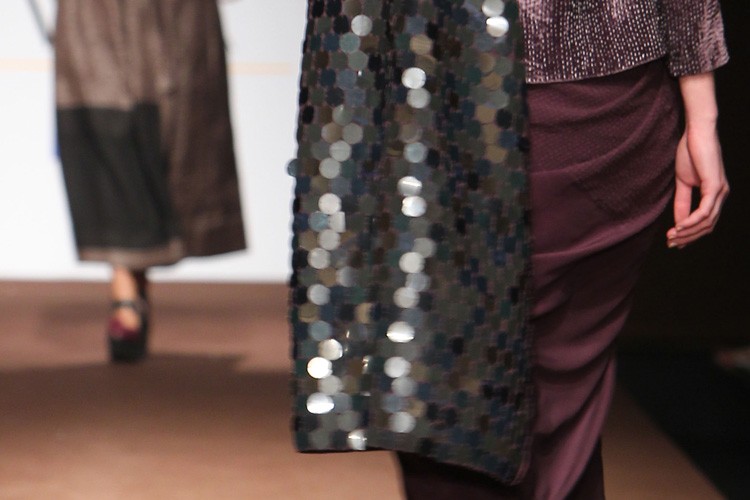
© Abraham & Thakore
3 years later, Vogue reported on the way they their new collection “sought to reduce and streamline voluminous Indian silhouettes into more western proportions”. They re-invented Indian traditions like the lehenga, and offered up the one-shouldered sari dress.
The understanding of what Indian professional women seek reflects an awareness of their reality, which they explain is also about appreciating what their customers don’t want:
They don’t want to wear saris for fear that they might look like aunties. Salwar kameezes are not an option. Western-style skirt suits can make you look like an airhostess.
Sustainable Fashion:
Doing It Rather Than Talking About It
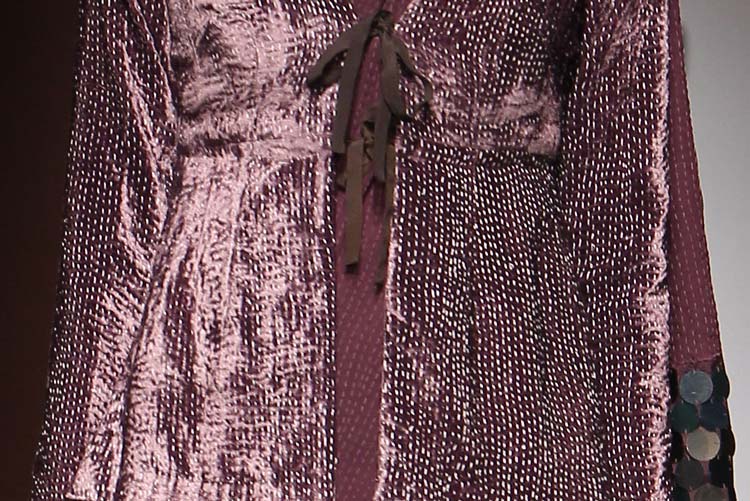
© Abraham & Thakore
Sustainable Fashion is very important to Abraham and Thakore. This is what led us to find them in the first place. It’s important enough that they made the conscious decision early on to make it a core part of their whole approach to their work.
We mentioned them in our Zayah World Guide to Sustainable Fashion, as one of our three inspiring examples of sustainable fashion in practice today. They recognise more than most the role designers can play in changing attitudes, behaviours and business practices.
Sustainability at the Heart of their Business
So not for them an occasional or one-off “sustainable collection”, or PR-motivated marketing exercise to promote their green credentials.
Instead, sustainability is built into their work in three main ways.
- Sustainable fashion is part of day to day practice throughout their supply chain, focusing on waste and reuse.
- They are proponents of the idea that sustainable fashion can be an exercise in creativity. So sustainability themes are explored and integrated within collections, not separately.
- Perhaps most importantly, they recognise the influence they can exert on those around them. But in typical Abraham and Thakore style, it’s about thoughtful words spoken quietly (but firmly), and leading by example with actions.
The first priority in making a fashion business sustainable is to minimise waste, and strive to re-use any waste that can’t be avoided.
Abraham and Thakore do that very well in their business, but then take it further by working with their suppliers to ensure they are also doing the best they can to achieve the same ends.
Sustainability as a Creative Challenge
But to make a step change from there, they approach sustainability as a design challenge, such as the example we described in the Sustainable Fashion Guide: their use of discarded X-rays and bottle tops to create sequins.
They also understand better than most that Indian society has a strong history of re-use in the home, starting with hand-me-down clothes, and repairing worn clothes being the preferred alternative to throwing them away. But it goes much deeper, for example the Bengali technique of Kantha, where old saris and fabrics are layered and stitched to create completely new attractive fabrics.
A typical collection might include: antique recycled brocade trims and ribbons; reclaimed cotton, wool, nylon and polyester fabrics; Kantha-made borders; discarded x-ray sequins; and recovered bottle cap trim.
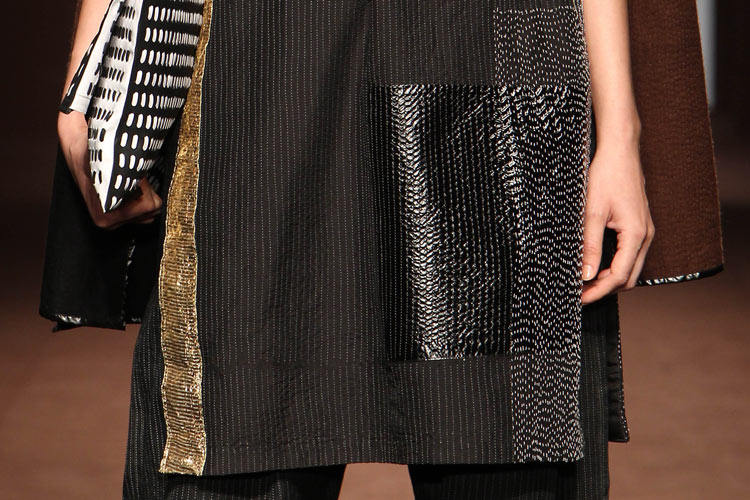
© Abraham & Thakore
And the reaction from the fashion industry establishment? Perhaps best demonstrated by what mainstream Indian fashion blog MissMalini.com said to its five million+ social media followers:
Thank You Abraham & Thakore For Proving That Sustainable Fashion Can Be Ultra Stylish!
Like so many matters of principle or social change in the world, there are many people who speak loudly and stridently about the things that matter to them.
But Abraham and Thakore show that results can be at least effective from those who speak more quietly, or even not at all, but are putting the same values into practice in daily life.
Some call this “being the change”, and it is an apt label for David and Rakesh.
We believe Abraham and Thakore are inspirational at many levels, and possess an uncommon mix of talent, values and personality.
But we would single out their attitude to Sustainable Fashion for special mention.
Sustainable Fashion is something very close to our own hearts, and we especially believe that designers and celebrities can have a disproportionate impact on how quickly things change in practice. No one demonstrates this better than Abraham and Thakore.
We also believe consumers should be informed about what Sustainable Fashion is and means. And if they want to be part of increasing its adoption, they have a powerful collective voice to tell the industry it’s important to them.
One message to share with their favourite designers and stores is they’d like to have a much wider choice of sustainable fashion.
And Abraham and Thakore are one of the best examples of how to do that without compromising on success, with lessons that everyone in the industry can learn from.


